NVIDIA’s GeForce GTX Titan Review, Part 2: Titan's Performance Unveiled
by Ryan Smith & Rahul Garg on February 21, 2013 9:00 AM ESTTitan’s Compute Performance (aka Ph.D Lust)
Because GK110 is such a unique GPU from NVIDIA when it comes to compute, we’re going to shake things up a bit and take a look at compute performance first before jumping into our look at gaming performance.
On a personal note, one of the great things about working at AnandTech is all the people you get to work with. Anand himself is nothing short of fantastic, but what other review site also has a Brian Klug or a Jarred Walton? We have experts in a number of fields, and as a computer technology site that includes of course includes experts in computer science.
What I’m trying to say is that for the last week I’ve been having to fend off our CS guys, who upon hearing I had a GK110 card wanted one of their own. If you’ve ever wanted proof of just how big a deal GK110 is – and by extension Titan – you really don’t have to look too much farther than that.
Titan, its compute performance, and the possibilities it unlocks is a very big deal for researchers and other professionals that need every last drop of compute performance that they can get, for as cheap as they can get it. This is why on the compute front Titan stands alone; in NVIDIA’s consumer product lineup there’s nothing like it, and even AMD’s Tahiti based cards (7970, etc), while potent, are very different from GK110/Kepler in a number of ways. Titan essentially writes its own ticket here.
In any case, as this is the first GK110 product that we have had access to, we couldn’t help but run it through a battery of tests. The Tesla K20 series may have been out for a couple of months now, but at $3500 for the base K20 card, Titan is the first GK110 card many compute junkies are going to have real access to.
To that end I'd like to introduce our newest writer, Rahul Garg, who will be leading our look at Titan/GK110’s compute performance. Rahul is a Ph.D student specializing in the field of parallel computing and GPGPU technology, making him a prime candidate for taking a critical but nuanced look at what GK110 can do. You will be seeing more of Rahul in the future, but first and foremost he has a 7.1B transistor GPU to analyze. So let’s dive right in.
By: Rahul Garg
For compute performance, we first looked at two common benchmarks: GEMM (measures performance of dense matrix multiplication) and FFT (Fast Fourier Transform). These numerical operations are important in a variety of scientific fields. GEMM is highly parallel and typically compute heavy, and one of the first tests of performance and efficiency on any parallel architecture geared towards HPC workloads. FFT is typically memory bandwidth bound but, depending upon the architecture, can be influenced by inter-core communication bandwidth. Vendors and third-parties typically supply optimized libraries for these operations. For example, Intel supplies MKL for Intel processors (including Xeon Phi) and AMD supplies ACML and OpenCL-based libraries for their CPUs and GPUs respectively. Thus, these benchmarks measure the performance of the combination of both the hardware and software stack.
For GEMM, we tested the performance of NVIDIA's CUBLAS library supplied with CUDA SDK 5.0, on SGEMM (single-precision/fp32 GEMM) and DGEMM (double precision/fp64 GEMM) on square matrices of size 5k by 5k. For SGEMM on Titan, the data reported here was collected with boost disabled. We also conducted the experiments with boost enabled on Titan, but found that the performance was effectively equal to the non-boost case. We assume that it is because our test ran for a very short period of time and perhaps did not trigger boost. Therefore, for the sake of simpler analysis, we report the data with boost disabled on the Titan. If time permits, we may return to the boost issue in a future article for this benchmark.
Apart from the results collected by us for GTX Titan, GTX 680 and GTX 580, we refer to experiments conducted by Matsumoto, Nakasato and Sedukin reported in a technical report filed at the University of Aizu about GEMM on Radeon 7970. Their exact parameters and testbed are different than ours, and we include their results for illustrative purposes, as a ballpark estimate only. The results are below.
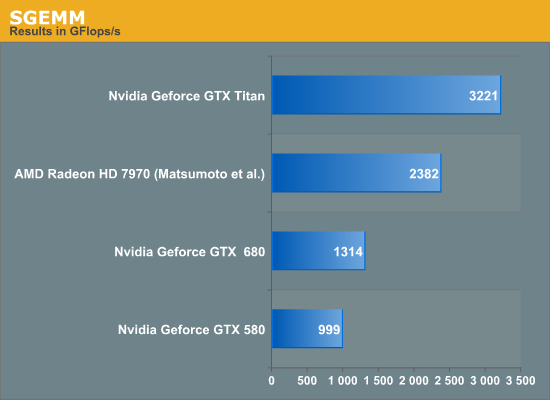
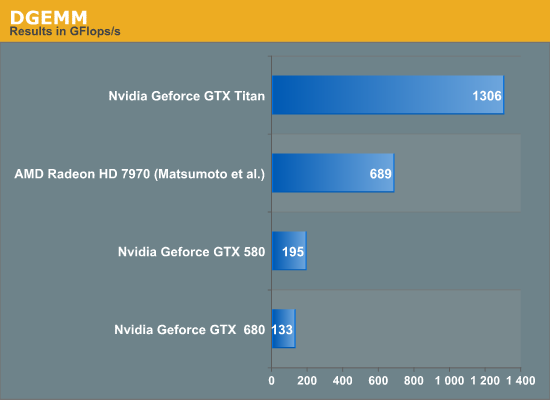
Titan rules the roost amongst the three listed cards in both SGEMM and DGEMM by a wide margin. We have not included Intel's Xeon Phi in this test, but the TItan's achieved performance is higher than the theoretical peak FLOPS of the current crop of Xeon Phi. Sharp-eyed readers will have observed that the Titan achieves about 1.3 teraflops on DGEMM, while the listed fp64 theoretical peak is also 1.3 TFlops; we were not expecting 100% of peak on the Titan in DGEMM. NVIDIA clarified that the fp64 rating for the Titan is a conservative estimate. At 837MHz, the calculated fp64 peak of Titan is 1.5 TFlops. However, under heavy load in fp64 mode, the card may underclock below the listed 837MHz to remain within the power and thermal specifications. Thus, fp64 ALU peak can vary between 1.3 TFlops and 1.5 TFlops and our DGEMM results are within expectations.
Next, we consider the percentage of fp32 peak achieved by the respective SGEMM implementations. These are plotted below.
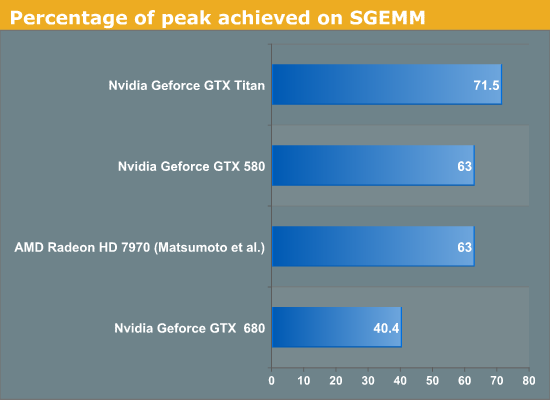
Titan achieves about 71% of its peak while GTX 680 only achieves about 40% of the peak. It is clear that while both GTX 680 and Titan are said to be Kepler architecture chips, Titan is not just a bigger GTX 680. Architectural tweaks have been made that enable it to reach much higher efficiency than the GTX 680 on at least some compute workloads. GCN based Radeon 7970 obtains about 63% of peak on SGEMM using Matsumoto et al. algorithm, and Fermi based GTX 580 also obtains about 63% of peak using CUBLAS.
For FFT, we tested the performance of 1D complex-to-complex inplace transforms of size 225 using the CUFFT library. Results are given below.
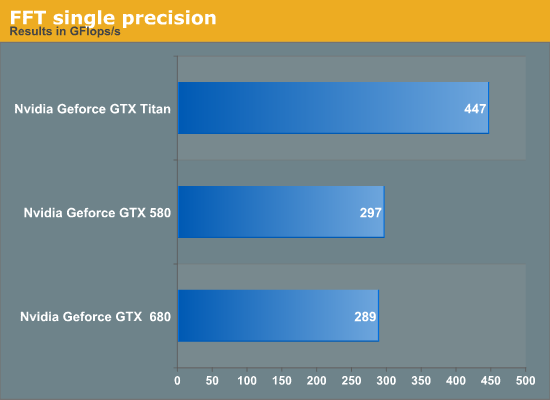
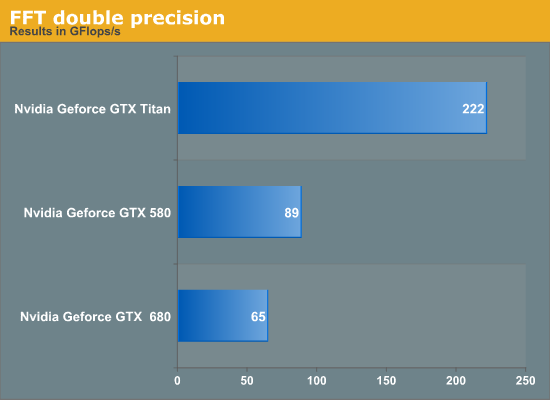
Titan outperforms the GTX 680 in FFT by about 50% in single-precision. We suspect this is primarily due to increased memory bandwidth on Titan compared to GTX 680 but we have not verified this hypothesis. GTX 580 has a slight lead over the GTX 680. Again, if time permits, we may return to the benchmark for a deeper analysis. Titan achieves about 3.4x the performance of GTX 680 but this is not surprising given the poor fp64 execution resources on the GTX 680.
We then looked at an in-house benchmark called SystemCompute, developed by our own Ian Cutress. The benchmark tests the performance on a variety of sample kernels that are representative of some scientific computing applications. Ian described the CPU version of these benchmarks in a previous article. Ian wrote the GPU version of the benchmarks in C++ AMP, which is a relatively new GPGPU API introduced by Microsoft in VS2012.
Microsoft's implementation of AMP compiles down to DirectCompute shaders. These are all single-precision benchmarks and should run on any DX11 capable GPU. The benchmarks include 2D and 3D finite difference solvers, 3d particle movement, n-body benchmark and a simple matrix multiplication algorithm. Boost is enabled on both the Titan and GTX 680 for this benchmark. We give the score reported by the benchmark for both cards, and report the speedup of the Titan over 680. Speedup greater than 1 implies Titan is faster, while less than 1 implies a slowdown.
| Benchmark | GTX 580 | GTX 680 | GTX Titan |
Speedup of Titan over GTX 680 |
| 2D FD | 9053 | 8445 | 12461 | 1.47 |
| 3D FD | 3133 | 3827 | 5263 | 1.37 |
| 3DPmo | 41722 | 26955 | 40397 | 1.49 |
| MatMul | 172 | 197 | 229 | 1.16 |
| nbody | 918 | 1517 | 2418 | 1.59 |
The benchmarks show between 16% and 60% improvement, with the most improvement coming from the relatively FLOP-heavy n-body benchmark. Interestingly, GTX 580 wins over the Titan in 3DPMo and wins over the 680 in 3DPmo and 2D.
Overall, GTX Titan is an impressive accelerator from compute perspective and posts large gains over its predecessors.










337 Comments
View All Comments
Tetracycloide - Thursday, February 21, 2013 - link
That's the thing, it's not a 'consumer gaming card.' It's a consumer compute card. Obviously the price for performance for gaming makes no sense but that's not their target market.ronin22 - Thursday, February 21, 2013 - link
This exactly!It's an amazing card for computing.
I wish I could get one...
Blazorthon - Thursday, February 21, 2013 - link
In reply to both of your comments, I have to ask this: If that is justification for its price, then why is it that AMD doesn't have their Tahiti cards priced like that and why didn't Nvidia price their previous consumer compute cards like that (GTX 280, GTX 285, GTX 480, GTX 580, etc.)?CommandoCATS - Friday, February 22, 2013 - link
Because this seems like a specialized thing for people who care about compute tasks within NVidia's CUDA universe (and things like iRay, which didn't exist when previous generations first came out).The truth is that in academia and research, CUDA is still the top dog (just do a google scholar search). I'm sure for most gamers, the GTX 680 is the way better deal. However, this is essentially a Tesla K20 for 1/3rd of the cost, so it's kind of a bargain from that perspective.
cheersloss - Saturday, February 23, 2013 - link
Exactly right. There is nothing about this card that is a value. The same compute functions were there in the older flagships as well, the gtx 580, 480, 280 etc.Titan is just an overpriced, overhyped trainwreck. Another attempt at a cashgrab on the gullible.
CeriseCogburn - Saturday, February 23, 2013 - link
The gullible that have the several thousands of extra they can spend that you don't have and cannot spend.Certainly poorboy feels better after having called his superiors gullible. The jelly is seeping through at an extraordinary rate.
cheersloss - Saturday, February 23, 2013 - link
Exactly right. There is nothing about this card that is a value. The same compute functions were there in the older flagships as well, the gtx 580, 480, 280 etc.Titan is just an overpriced, overhyped trainwreck. Another attempt at a cashgrab on the gullible.
CeriseCogburn - Saturday, February 23, 2013 - link
LOLGood you run the 280, and I'll run the Titan, and we can be equal and best friends, and I'll tell you over and over all the benchmarks and games and fps scores and compute tests are lying and your 280 is just as good and the same and you're right and I wish so badly that I was as poor as you and just bought a used 3 gen back nVidia card, but they fooled me, the gullible gamer.
CeriseCogburn - Tuesday, February 26, 2013 - link
ROFL - aww poor baby, now tessellation and compute is a total loss for amd, too as you conveniently forgot to include the 680, 670 660Ti 660 650Ti 650. hahahahha u people suck.So I can buy 2 amd cards that crash and don't run CF at all 33% of the time, or I can buy the most awesome top card in the entire world of gaming and play all the titles and be just great, or I can buy 2 nVidia cards and SLI them and have every game run except correctly except 1 while amd CF fails often...
I can buy the most stable, fully featured, many more featured nVidia card, or I can buy the dying no catalyst driver writers worth their salt (fired for savings) or left for better waters or headhunted, crashing piece of rotten unsupported glitching amd crap.
$999 looks like a bargain basement price to me. I can hardly wait to own The Shield, too.
Innovation. Awesomeness. New features. Unified drivers THAT JUST WORK.
Features ported BACKWARDS to prior generations.
Cuda
PhysX
Frame Rate Target
Boost
Stable dual card setups
Same game day drivers
Honest company not cheating liars like amd
I BUILT THIS co-founder Jen-Hsun Huang current CEO, a perfect example of the awesomeness of capitalism and personal success and the American Dream in REAL LIFE. lol
( Oh I bet those little OWS activist amd fanboys we have here are shooting blood through every pore)
Why in the world would I buy an amd card ? There's only one reason - to try to save a dying loser in a kind act of CHARITY - and frankly, what we have for amd fanboys is nothing short of the most evil little penny pinching crying whining baby SCROOGES I have ever seen.
So we can FORGET IT when it comes to the amd fanboy rabble here supporting AMD - they support only their own selfish fanboy agenda and psychotic public pocketbook panhandling.
I'd like to thank TheJian for pointing out amd fail coverage, vs the ignoring of the nVidia FINANCIAL SUCCESS STORY:
amd Q earnings coverage
"
http://www.anandtech.com/show/5465/amd-q411-fy-201...
http://www.anandtech.com/show/5764/amd-q112-earnin...
http://www.anandtech.com/show/6383/amd-q3-2012-ear...
http://www.anandtech.com/show/6690/amd-q412-and-fy...
"
nVidia Q earnings coverage
http://www.anandtech.com/show/6746/tegra-4-shipmen...
LOL - let it burn you crybabies to the CORE, I hope blood shoots from your eyes...
xaml - Sunday, March 3, 2013 - link
Don't leave out the biggest "crybaby" of all, yourself.